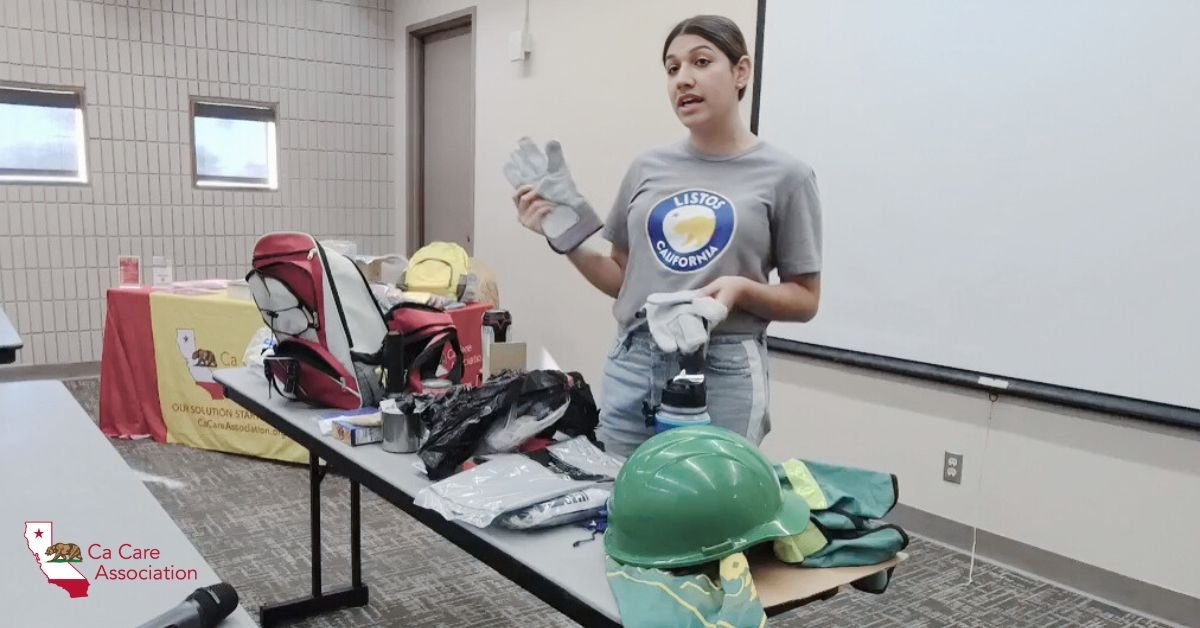Emergency GO BAG Essentials: Key Learnings from Our Latest Preparedness Workshop
Nadia Wiggins sharing the contents of her Go Bag
Ca Care Association in partnership with Listos California recently had a GO BAG preparedness workshop in Carson Community Center last January 12, 2024. This training is aimed at teaching the community about emergency preparedness by educating them about the importance of a go bag and how to ready their own. The event was led by Nadia Wiggins from Listos California who shared professional insights about go bags and the essentials needs of everyone in case of emergencies.
What is a GO BAG?
A GO BAG, often referred to as an emergency bag or survival kit, is a portable, well-stocked collection of items essential for survival in emergencies such as floods, power outages, earthquakes, and many more. The primary purpose of a GO BAG is to provide immediate access to necessities that one might need in an emergency, especially when there is no time to gather items from around the home. Nadia Wiggins shared that go bags should be placed in easily accessible areas such as the fire door, under the bed, car, etc...
Having a GO BAG ready means being prepared for the unexpected, reducing panic and confusion during high-stress situations. These bags are not just for individuals or households; they are also recommended for workplaces, schools, and vehicles Go bags are essential for everyone especially those living in areas that are prone to disasters. By having a go bag, individuals and families can ensure survival and comfort during emergencies.
What Should be Included in a GO BAG?
Individuals should customize their go bag according to their needs and not according to the different types of emergencies. A senior individual could have different items in their go bag specific to their needs compared to children. Nevertheless, some items are a necessity for everyone.
Nadia Wiggins shared all of the items she has in her go bag including:
Listos California Disaster Ready Guide: click here to download
Water bottle with filtration straw
Filtration straw to use for other bottles
Prepackaged water (take note of the expiration dates)
Hard, reusable containers
Aqua tabs to purify the water with an instruction sheet
Collapsable cooking stove
One day’s worth of food
9. Flashlights
10. Headlight
11. Small portable radio
12. First aid kit
Wipes
Bandage wraps
Antiseptic wipes
Mini first aid booklet
Triangle bandage
Gloves
13. Ice pack
14. Face mask
15. Rain poncho
16. Small blanket
17. Hand warmers
18. Trashbag
19. Cardboard (for bandaging to hold body parts in place)
20. Lightstick
21. Vest and helmet (hard hat)
22. Sturdy gloves
23. Goggles
24. Small picnic blanket
25. Portable charger (solar-powered)
26. Hygiene kit
Toothbrush
Toothpaste
Tissue
Feminine hygiene product
Towel
Cleaning gloves
Soap
27. Safety whistle
28. Waterproof matches
29. Oil pen
30. Swiss army knife
31. Tape measure
32. Refrigerator food safety guide
33. Important Documents
Disaster Ready Card
Map of location
Photos of loved ones
Emergency phone numbers
Emergency personnel numbers
Number of local sheriff’s office
911, 211, 311
Number of doctors
Out-of-state contact
Out-of-country contact
Insurance
38. Medication
39. Cash
Now you don't need to have all of these but it's better if you do. You can start with the basics and then continue to pack items little by little until you have a go bag that contains all of your needs.
A basic GO BAG should contain essential items to help you survive and stay comfortable during the initial hours or days of an emergency. Here's a list of such essentials:
Water: At least one gallon per person per day for at least three days, for drinking and sanitation.
Non-perishable Food: A three-day supply of ready-to-eat, high-energy foods like canned goods, energy bars, and dried fruits.
First Aid Kit: Including bandages, antiseptic wipes, pain relievers, and any necessary prescription medications.
Flashlight and Extra Batteries: A reliable light source is crucial in power outages.
Battery-Powered or Hand-Crank Radio: To stay updated on emergency instructions and news.
Multi-Tool or Swiss Army Knife: For various practical needs, from opening cans to making minor repairs.
Personal Hygiene Items: Such as toothbrush, toothpaste, soap, feminine hygiene products, and wet wipes.
Clothing and Bedding: A change of clothes for each family member and a sleeping bag or warm blanket per person.
Important Documents: Copies of identification, insurance policies, medical records, and emergency contact numbers in a waterproof container.
Cash: In case ATMs are not operational or accessible.
Mobile Phone with Chargers: Include a backup battery or a solar charger.
Emergency Contact Information: List of family contacts and local emergency numbers.
Maps of the Area: In case GPS on electronic devices is unavailable.
Whistle: To signal for help.
You can use the Listos California GO BAG guide to help you start yours.
Access it here
Keeping Your Go Bag Up-to-Date
Go Bags should always be kept current and up-to-date to ensure its effectiveness in an emergency. Here are some tips to maintain your go bag:
Regularly Check Expiration Dates: Periodically review all items, especially food, water, and medication, for expiration dates. Replace any items that are nearing the end of their shelf life.
Seasonal Adjustments: Update your GO BAG with seasonal clothing and bedding to ensure comfort and protection from the weather, whether it’s extra blankets for winter or lightweight clothing for summer.
Evaluate Family Needs: As your family grows or changes, so do your needs. Regularly assess and update your GO BAG to include items for new family members, including children or pets, and remove items that are no longer necessary.
Update Documents: Keep copies of important documents in your GO BAG and ensure they are current. This includes personal identification, medical records, and emergency contact information.
Battery Checks: Regularly check and replace batteries in flashlights, radios, and other battery-operated items to ensure they are functional when needed.
Conclusion
Ca Care’s go bag workshop with Listos California is a valuable workshop that emphasizes the significance of emergency preparedness. Go bags should always be customized according to the needs of the individual rather than the specific emergency. Always remember to regularly update its contents, and ensure its accessible in an emergency. Start with the essentials like food, water, a first aid kit, and important documents, then build from there. Remember, the right preparation today can be a lifesaver tomorrow. Stay prepared and stay safe!
Visit Listos California for more resources regarding emergency preparedness.
https://www.listoscalifornia.org/disaster-readiness/
Click down below to become a member of Ca Care Association and gain easy access to workshops like this.
https://www.cacareassociation.org/memberships



